City of Mount Isa
| City of Mount Isa Queensland | |||||||||||||
|---|---|---|---|---|---|---|---|---|---|---|---|---|---|
 Location within Queensland | |||||||||||||
| Population | 22,517 (2015 Est)[1] | ||||||||||||
| • Density | 0.519440/km2 (1.345344/sq mi) | ||||||||||||
| Established | 1914 | ||||||||||||
| Area | 43,348.6 km2 (16,737.0 sq mi) | ||||||||||||
| Mayor | Joyce McCulloch | ||||||||||||
| Council seat | Mount Isa | ||||||||||||
| State electorate(s) | Mount Isa | ||||||||||||
| Federal Division(s) | Kennedy | ||||||||||||
 | |||||||||||||
| Website | City of Mount Isa | ||||||||||||
| |||||||||||||
The City of Mount Isa is a local government area in north west Queensland. The City covers the urban locality of Mount Isa, the administrative centre, and surrounding area, sharing a boundary with the Northern Territory to the west.
Mount Isa is a reasonably affluent district. The largest industry in the City is the Mount Isa Mines, a source of lead, copper, silver and zinc. Cattle grazing and tourism are other industries of note.
History
On 10 February 1914, the Shire of Barclay Tableland, based in Camooweal, was incorporated on an area previously managed by the shires of Burke and Cloncurry. On 14 August 1919 the spelling was changed and it became known as Shire of Barkly Tableland. As a consequence of the growth of Mount Isa as a mining and population centre within the shire, an Order in Council dated 15 December 1962 renamed the shire to Shire of Mount Isa, effective 1 July 1963, and its administration centre relocated to Mount Isa. At the same time it gained part of the Shire of Cloncurry. On 30 May 1968, the shire was proclaimed as a City due to the area reaching a population of 18,000.
Towns and localities
The City of Mount Isa includes the following settlements:
Suburbs of the town of Mount Isa
|
Mineside Mount Isa:
|
Townside Mount Isa:
|
|
Rural areas outside the town
Chairmen and mayors
- 1927: John Thomson Campbell [2]
Sister cities
Sister cities of Mount Isa include:
 Bankstown, Sydney, New South Wales
Bankstown, Sydney, New South Wales
Population
| Year | Population |
|---|---|
| 1954 | 7,884 |
| 1961 | 13,967 |
| 1966 | 17,485 |
| 1971 | 26,502 |
| 1976 | 26,536 |
| 1981 | 24,390 |
| 1986 | 23,927 |
| 1991 | 24,735 |
| 1996 | 22,866 |
| 2001 | 21,636 |
| 2006 | 21,201 |
References
- ↑ "3218.0 – Regional Population Growth, Australia, 2014–15". Australian Bureau of Statistics. Retrieved 29 September 2016.
- ↑ Pugh, Theophilus Parsons (1927). Pugh's Almanac for 1927. Retrieved 13 June 2014.
Coordinates: 20°43′29″S 139°29′37″E / 20.72472°S 139.49361°E